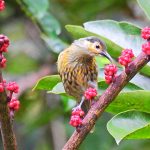MACLEAY'S HONEYEATER
The Macleay’s Honeyeater is a medium-sized bird, measuring about 18 to 20 centimetres in length. Its plumage is a blend of earthy tones, predominantly olive-brown, which helps it blend seamlessly into its forest habitat. Its underparts are lighter, often with a yellowish tinge, while its face is marked by a distinct white stripe running from the base of the beak to the back of the head. This stripe is complemented by a dark eye patch, giving the bird a somewhat masked appearance. Its beak is slightly curved, perfect for accessing nectar.
This species is primarily found in the rainforests of north-eastern Queensland. It thrives in the lush, dense foliage of these tropical forests, often seen flitting among the trees in search of food. The Macleay’s Honeyeater is particularly associated with the Wet Tropics region, an area renowned for its rich biodiversity.
Macleay’s Honeyeaters are known for their cup-shaped nests, which they construct from a variety of materials such as twigs, leaves, and spider webs. These nests are usually well-hidden in the dense foliage to protect from predators. The breeding season typically occurs from September to January. During this time, the female lays two to three eggs, which she incubates with care. Both parents are involved in feeding the chicks once they hatch, ensuring they grow strong and healthy.
As their name suggests, honeyeaters primarily feed on nectar, which they extract from flowers using their specialised brush-tipped tongues. These birds play a crucial role in their ecosystem as pollinators, which is vital for the reproduction of many plant species. However, they are not strictly nectarivorous; they also consume insects and fruits, making them important pollinators and seed dispersers within their ecosystem. Their diet is quite varied, allowing them to adapt to different food availabilities throughout the year.
While specific lifespan data for the Macleay’s Honeyeater is limited, honeyeaters in general can live for several years in the wild, assuming they navigate the challenges of predation and food scarcity. Captive honeyeaters have been known to live longer due to controlled conditions and consistent food supply.
The Macleay’s Honeyeater has a distinctive call, often described as a series of melodious whistles and chirps. These vocalisations are used for communication between individuals, especially during the breeding season when establishing territory and attracting mates is crucial.
The Macleay’s Honeyeater is named after William Sharp Macleay, a British entomologist and zoologist.
While currently not listed as threatened, the Macleay’s Honeyeater relies on the preservation of its rainforest habitat. Conservation efforts focused on protecting these environments are essential for the continued survival of this species and countless others that share its home.









